Antonio & Ramón de Irureta Goyena
Thursday, May 31, 2007
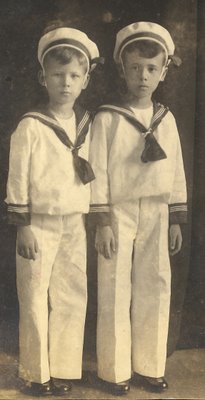
Rosemary returned on Tuesday night from a trip to visit her older sister Ruth near New Dublin, Ontario. The town where both of them lived, New Dublin is now almost a ghost town. The church and school were closed and the few children that remain are bussed to school. Not surprisingly, the cemetery, with beautifully old tombstones from the 18th century is kept up. Memory for those we long ago forgot is kept alive while the owners of Rosemary's ancestral home would never know that Rosemary's father, Frank, built it from scratch. It was a sad occasion for Rosemary to drive by her old house.
We had a garden barbecue yesterday and the Waterhouse-Haywards (Rosemary and Ale) and the Stewarts (Hilary, Bruce, Lauren and Rebecca) came. It was a beautiful evening and after we ate, Rebecca, Lauren and Ale had sword fights with paper towel cores. Meanwhile Hilary grilled Rosemary about her trip and enquired about her cousins. Rosemary had brought old photographs (many were some of the first colour prints I had printed some 30 years ago) and stuff that Ruth had kept. Rosemary did not bring her mother's recipe books and Hilary who is a keen cook was adamant that she wants them.
It was here that Ale hit me brutally without knowing it. But I am so glad she did. She said, "Yes let's get those recipe books. We don't want people to look at them and wonder what they are." In my head I saw a garage sale with a pile of recipe books that would be purchased a few at a time by innocent but interested buyers. Somehow the memory of Rosemary's mother would be furthed diluted by it.
And yet except for the powerful or the notorious who can build monuments for their remembrance or for the impetuousness of Achilles who will always be remembered in having snubbed King Agamemnon it is our fate to be forgotten within a couple of lifetimes.
Antonio (left) and Ramón (right) de Irureta Goyena were half brothers of my grandfather don Tirso de Iruteta Goyena. Everybody always noticed that I was the spitting image of Antonio. I may be the last person to know who Antonio was (but I will never know what became of him). Some day this photo just might be looked at by one of my decendants who will not know anything but perhaps smile at the curious sailor suits.
As long as I remember for a while (after having anticipated and then enjoyed it all yesterday) that Rebecca, Lauren and Ale had their sword fights in the beauty of our garden, nothing else really matters.
A Beautiful Aberration
Wednesday, May 30, 2007
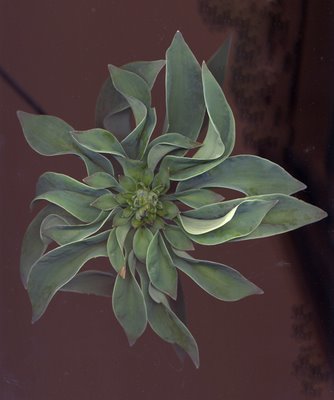
Hostas are generally prized for their leaves, particularly when they are variegated. Not many notice hosta flowers some of which can be extremely fragrant. Some flowers are striped and some are beautiful before they even open as they look like the beaks and heads of exotic oriental birds. The flowers of Hosta clausa are notable in that they never open.
I love hostas and spend time placing them so that they will look their best. If you plant a blue hosta next to a gold hosta the gold hosta will look golder and the blue one bluer. But hostas are not really blue or gold. The blue ones as defined by W. George Schmid in his The Genus Hosta
Blue-green (enhanced by temporary surface effects). A dull green passing into greyish blue, usually associated with a glaucous, caesious, pruinose, or glaucescent surface.
Some people believe that the "blue" coating of blue hostas (sometimes called the bloom) protects the plant from the harsh UV rays of the sun. Many blue hostas originated in the high mountain areas of Japan. This blue coating reflects UV in the same way as sun block does. When you photograph a blue hosta (specially in the shade with the added blue of shade) it will look an unnatural blue. The reason is that both film and digital cameras are more sensitive to UV than we humans are.
Hosta 'Buckshaw Blue' is one of the bluest of my blue hostas. It has white flowers. By the beginning of June the leaves are a startling blue-green. This year Buckshaw Blue surprised me with a vegetative aberration (hosta experts are not sure why hostas do this) that is a combination of a large hosta flower with extra thick, small and narrow leaves. The whole structure which I would call a rosette is 8 inches across.
Blue hostas remain blue longer in our cooler climates. In the south of the US with their hot and humid climate the bloom disappears by the end of June while in Vancouver the colour persists well into August. It is not polite to touch a blue hosta as touch will leave a blemish and you will never be invited to that garden again.
Addendum by W. George Schmid
As you do, I like those large crowns of bracts (a true bract is protective leaf covering usually associated with a developing flower). Bracts is what I call these scape/raceme leaves. You must have has more rain than normal. During very wet weather, the bracts sometimes grow larger and become leaf-like and get way ahead with their growth process before scape/raceme elongation separates the bracts longitudinally and the "crown dissolves." In the fold of each of the upper bracts hides a flower and that is why they are called fertile bracts. These fertile bracts may be joined by several bracts emerging below the fertile bracts. These do not have a flower hiding in the "wings." They are sterile bracts, sometimes called bracteole. As stated above, the whole leafy menagerie is occasionally way ahead of scape/raceme elongation and flower development and so grows into a leafy cluster. The right genetic background also helps in the development of these flamboyant bud covers (looking much like a leafy crown), to wit, one of its grandparents (in the H. sieboldiana/H. ' Tokudama' group) regularly goes though a stage in its growth cycle, when the bracts form a similar leafy crown, but not as exaggerated as the one seen in your picture. Other hostas also form these leafy structures, like the one (shown on plate 138 of my book) on H. 'Undulata'). Enjoy it when and while you can, it may not develop this way next year. I love Nature, it is so much more entertaining than TV.
Greetings from the very dry South, George
W. George Schmid
Hosta Hill R. G.
USDA Zone 7a - 1188 feet (361m) AMSL
84-12'-30" W 33-51' N
Rosa 'Hansa' - Alexandra Elizabeth
Tuesday, May 29, 2007
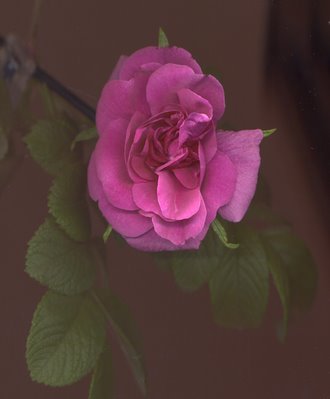
The Hanseatic League was an alliance of trading guilds that established and maintained a trade monopoly over the Baltic Sea, the North Sea, and most of Northern Europe for a time in the Late Middle Ages and the early modern period, between the 13th and 17th centuries. The member cities where either called Hanseatic cities or Hansa cities.
The German automobile company, The Borgward Group made cars called Hansas and the beautifully named Borgward Isabella and Arabellas of the 50s and 60s. They also made a Hansa 1100 that was efficient looking (the kindest word I can cook up). I remember it in the streets of Mexico City in the early 60s. The company went bankrupt in 1961 and for a while Mexico built Borgwards in the middle 60s.
In one of the contemporary rose bibles, Classic Roses - Peter Beales, Beales describes Rosa 'Hansa':
Schaum and Van Tol Holland 1905
Very free flowering. Double, highly scented, reddish-purple flowers. Vigorous, medium-sized plant with dark green foliage. Excellent red fruit. This is one of the best all-round Rugosas.
When my daughter gave me this rose three years ago I wondered why she had not picked (if it was to be a hybrid rugosa) a rose with a name like Lady Curzon, Sir Thomas Lipton or even Jens Munk. Hansa? That's not a name to slip one into nostalgic romance. But some further investigation into my memory (those Hansa cars in Mexico) and a little thought about the Hanseatic League convinced me that Schaum and Van Tol of Boskop had a legitimate reason to call such a beautiful rose by that deceptively mundane name. Enterprising and forward looking Dutch cities had been members of the League.
Much in the same way that in yesterday's posting I played the game of equating a plant/flower to my daughter Hilary I began to think of which one reminded me of my other daughter Alexandra Elizabeth (Ale, pronounced as in Alexandra after removing the xandra).
What is readily evident is that the plant that reminds me of Ale picked me and not the other way around. And that is the way that it should be. From the very beginning Ale was an independent soul and when her sister came along we dedicated a lot of time and attention to the more clingy Hilary. It is only many years later that as parents we realized that independent children need as much attention even if they don't ask for it. It is for this reason that Ale is more of a mystery to me than Hilary.
But she is efficient and dependable when efficiency and dependability are called for. In this way she is Rosa 'Hansa'. Rosa 'Hansa' is a cast iron rugosa and like all cast iron rugosas it will bloom with no care, in poor soil and adverse conditions. And rugosas are healthy and resent the care of sprays of any kind.
In the first year Hansa did not bloom even though I fertilized her and gave her water and all the care I could. Could Hansa be as unpredictable and independent as Ale is? I believe so.
Ale tends to dress in understated ways and buys most of her clothing at the Sally Anne. You just might not notice her. But every once in a while, she will dress up and with the exquisite manners and bearing she inherited from my mother she will take your breath away in the same way Hansa did this morning when I noticed her colour and her scent.
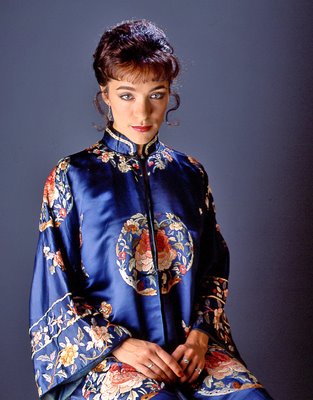
Hansa's scent cleared my memory of smells like my breakfast tea and bread, like a scrub brush. The perfume went to my brain like a laser.
Yesterday afternoon Ale was my left hand as I photographed a woman for the Reader's Digest on Granville Island. Her efficiency with my equipment while at the same time making my subject relax reflects her multi talents.
We are upset that she is abandoning her Vancouver teaching career for the uncertainty of Lillooet, B.C. where she will live on an acre in a little house, Rosemary says is a shack. The weather is one of extremes as it is a zone 4. Ale, who has several green thumbs will have a more restricted pallette of plants to chose from. But like Rosa 'Hansa' she will prosper (rugosas do just fine in zone 4).
The only problem to be resolved is: Where will I find a Hansa to give to Ale?
Hilary - That Cheerful Welsh Poppy
Monday, May 28, 2007
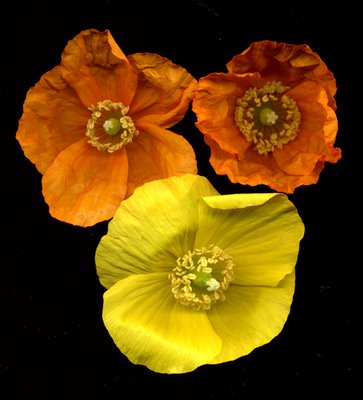
The Welsh poppy (Meconopsis cambrica) is a perennial plant of the family Papaveraceae. Its habitat is damp shady places on rocky ground, and it is native to south-western England, Wales, Ireland and Western Europe. In its most western locations, it is increasingly found on more open ground with less cover.
It has pinnately divided leaves. The flower is distinctively yellow or orange with four petals, and hairy green sepals that fall off quickly after the flower opens. It spreads easily from the numerous small black seeds produced in the summer. It is especially well adapted to colonising gaps and crevices in rocks and stones. This habit has enabled it to colonise the urban emvironment, growing between paving slabs and at the edges of walls.
The above little essay from Wikipedia deftly hides the fact that the Welsh poppy is a weed. When we arrived at our present home in 1986 Rosemary pulled this poppy wherever she saw it growing, in spite of the fact that Meconopsis cambrica previously known as Papaver cambrica ) is one weed that cheerfully lives and lets live. Rosemary's attempts at eradication failed somewhat as the cheerful little flower is back. Rosemary is far more forgiving about yellow and orange flowers now. At one time, as soon as our large clumps of Iris pseudacorus (yellow flag iris) showed hints of yellow buds, Rosemary snipped them off. Perhaps she has less time now or she has come to accept that yellow isn't all that bad.
I have always valued the function of epicene names. These are names that don't readily reveal the person'sex. It is up to the person to define and make the name their own. And this is what my daughter Hilary has done, and she has done it well indeed.
Hilarius or Hilary (ca. 300 – 367) was bishop of Poitiers and I have no idea if the patron saint that protects us from snake bites was hilarious or cheerful in any way. His life was changed when he read the scriptures verse where God tells Moses "I AM WHO I AM" (Exodus 3:14), St. Hilary said, "I was frankly amazed at such a clear definition of God, which expressed the incomprehensible knowledge of the divine nature in words most suited to human intelligence."

Hilary is cheerful and most steadfast as to who she is. I distinctly remember her telling me some years past when I criticized her for some action, "I am who I am and if you don't like it well then...." Just like those Welsh poppies, that are so much like her, she asserts her presence, and lives and lets live.
A Quirky Crystal
Sunday, May 27, 2007

Today at 3:30 I will be enjoying (a privilege, really) of watching Crystal Pite dance in a work in progress. Not too many get invited to this sort of thing. I am lucky. The quirky Pite posed with some friends from Ballet B.C. here, below. Only Pite would suggest to not face the camera.
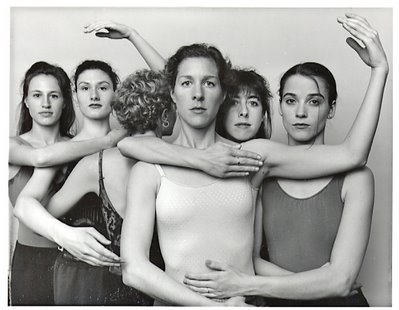
Karen McSherry
Saturday, May 26, 2007
stewardesses
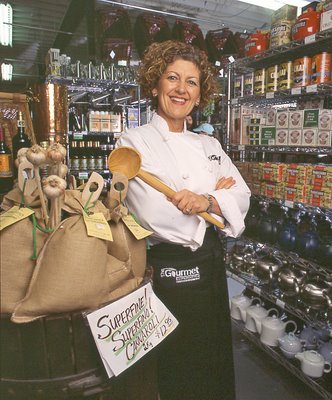
The significance of the above word is that it is the longest word in the English language that can be typed only with the fingers of the left hand. This is something that I am unable to do today. The pain is excruciating. So this will have to pass for today's blog. McSherry, ex stewardess, owns and runs the excellent Gourmet Warehouse where I buy my Maldon Salt and my Yorkshire Gold leaf tea.
The French Go Gaga For Ancient Egypt
Friday, May 25, 2007

I waited from 6:30 until 1pm and was then admitted into the pre-op room of the Vancouver General Hospital. I inserted my belongings in a couple of plastic bags and put on my hospital-issue clothing. At around 2, Doctor O'Brien informed me it was a "no go" and that I was to return tomorrow at 11. Roaming the garden I noticed that Rosa 'Belle Isis' (left and below) is full of buds and that some will open over the weekend. I started to think about Egypt.
The French (and England and much of the world) went gaga for ancient Egypt and its artifacts because of Napoleon's campaign in 1798. In 1799 the French founded Institut de l'Egypte in Cairo which brought many scientists and archaeologists to the region. But it was French Army engineer Captain Pierre-François Bouchard, who discovered the Rosetta stone on July 15, 1799, while guiding construction work at Fort Julien near the Egyptian port city of Rosetta (now Rashid) which started the rush for Egyptian bric-a-bracs and furniture. It became a stampede when Jean-François Champollion finished the translation of the stone in 1824. In 1802 when the French troops surrendered to the British in Alexandria and Cairo they lost possession of the Rosetta stone. By a wonderful coincidence (but not to the French) the stone was taken back in 1802 to England and to the British Museum in the captured French frigate L'Egyptienne.
By 1845 there was a rose named after the Egyptian goddess of love, beauty and wisdom in Rosa 'Belle Isis'. There was nothing really unusual about this pink Gallica (many guess she's part Alba, too.), which blooms only once in the season, as there are many other similar Gallicas.
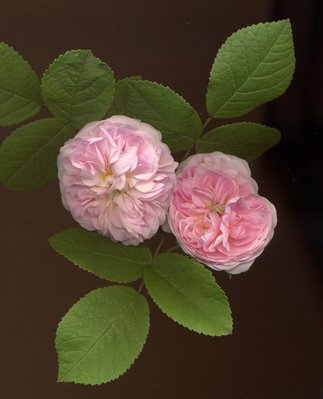
What made this rose unique was its scent of myrrh. The only other rose with this original scent at the time was Rosa 'Splendens' sometimes called Rosa 'Ayrshire Splendens' which was a mutation of the species rose, the only scrambling rose native to Britain, Rosa arvensis. Many hybridizers suspect that Louis Parmentier's Belle Isis must have Splendens in its parents.
In 1961 David Austin crossed Belle Isis with Dainty Maid and produced his first English Rose, Rosa 'Constance Spry' which is powerfully fragrant of myrrh.
Such is my obsession for myrrh that I have in my garden Rosa 'Splendens', Belle Isis (which I obtained from John Tuytle, Constance Spry and many more English Roses including Fair Bianca.
The unusual can be found just about anywhere in a garden if you happen to look closely. Belle Isis's buds are fit for the goddess of beauty, love and wisdom, are they not?
Jude Law, Athena, The Anesthetists & The Morgue
Thursday, May 24, 2007
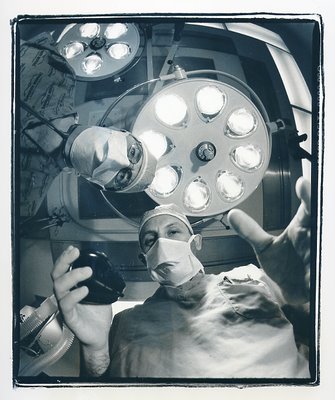
I am cheating a tad. Today by 6:30 A.M. I will be in the waiting room of VGH emergency for surgery on my left elbow. I wrote this yesterday.
My last meal (yesterday Wednesday) consisted of two soft boiled eggs (3 minutes 45 seconds) seasoned with Maldon Salt, Malabar pepper and unsalted cultured butter. Ditto the fresh corn (two cobs, 6 minutes, high setting in the microwave ) Rosemary bought for me before she flew to Brockville to visit her sister Ruth, Wednesday morning.
Tuesday I fell down some concrete steps and landed on my rib cage with the timely contribution of my left elbow. I decided it was first important to get Rosemary at the airport the next day slightly relaxed. This I did and then I spent most of yesterday at the doctors, at the X-rays and waiting to be admitted to emergency.
A handsome young man (the orthopedic surgeon's assistant, looked like a cross between Jude Law and a sculpture of a Greek athlete) indicated all was not well but did not go into details. The surgeon (I quickly visually undraped her and she looked like Athena's equivalent to Jude Law's athlete), explained that I had a little scrap of an elbow bone lodged where is should not be. Someone had to take it out.
It was here that I made a felicitous question, "Why is orthography all to do with writing and orthopedics all to do with bones?" Athena wisely knew the answer. "In antiquity we orthopedic surgeons straightened out crooked (physically) little boys and the name stuck. Ortho means straight." I was guessing that orthography had all to do with writing well and straight and with all the right punctuation. Athena added, "It is our hope that when we finish with you, you will again be able to straighten your left arm just like you do your right."
And then it got to the basics. I was warned that I might bleed and that I might get an infection. "There are always...risks." I signed the waiver and asked her if I was going to be put to sleep. "That's between you and your anesthetist."
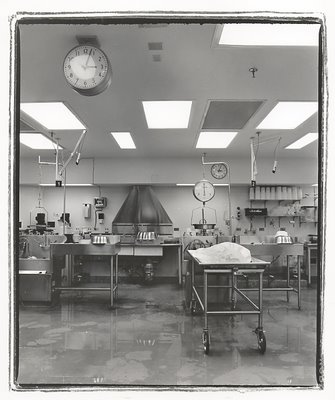
Since anything is possible I hope a third option (local anesthesia) is the available one. Here are the two others. The first is my photograph from an operating table of a couple of anesthetists and the other a photo I took at the VGH morgue.
Generally I am not afraid of doctors or hospitals as long as I don't see blood. But I was a bit shaken, nevertheless. Just when I was about to leave, Athena pulled out a black marker and put some marks on a spot on my left elbow. She looked at me and told me, "Don't remove that, we want to make sure the surgeon knows where to go."
My Fair Bianca
Wednesday, May 23, 2007

Am I your bird? I mean to shift my bush;
And then pursue me as you draw your bow.
You are welcome all.
Act 5, Scene 2 - The Taming of the Shrew
William Shakespeare
During Mexican President Adolfo López Mateo's 6-year tenure he visited the orient in the early 60s. To this day I remember reading the headlines in the Excelsior newspaper, "ALM (in those days, because of JFK, it was a fashionable thing) Sleeps With Mistress In Singapore." The details were quite funny as the mistress was a very large white pillow. Before the advent of air conditioning it was an oriental custom to sleep with a large pillow between one's legs. This prevented a hot leg from sweating on the other. Because of my own oriental roots ( my mother was born in Manila) I have always had the custom of sleeping while hugging a pillow. When I check into a hotel I always ask for an extra pillow. Without it I will stare at the ceiling all night. My pillow is not my only mistress. I have around 75 more, roses.
As a gardener for the last 20 years I have parted company with many plants who did not agree on my caring services. Most disappeared without saying goodbye. So in those initial years I tended to buy plants that were easy to grow. It would take more that the freezing temperature of Yellowknife to kill a hosta but I have managed to lose one of the cast iron hostas, Hosta yingeri that I proudly purchased at the UBC plant sale, years back.
So Rosemary and I have have what our friend Alleyne Cook calls "garden worthy" plants. These are plants that perform well without much effort or care. Recently when Rosemary brought home her third (the other two died) Rhododendron quinquefolium I called up Cook and asked him what the secret for keeping one alive was. His answer was a terse one, "There is no secret. They all die!"
There are many roses that are easy. A case in point is any rugosa rose. I have at least four in my garden. But many of my others are not so easy. Some are decidedly difficult.
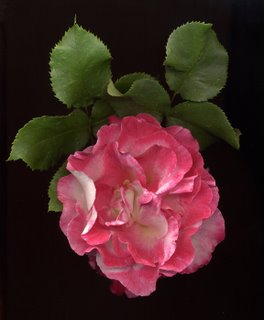
The Bourbons get black spot early on (by May 1) and R. 'Double Delight' (right) says goodbye every three years. One has to coax with fertilizer and lots of TLC to get Rosa 'Baron Girod De'Lain' (bottom, left) to bloom a couple (as in two flowers) of times per year.
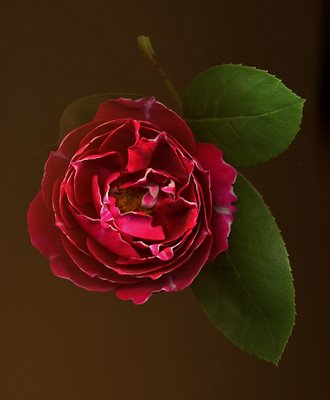
In less politically correct times I would simply say, "My roses are my mistresses. Mistresses are difficult but then they are almost always worth it." Or I might say, "A mistress, lots of pleasure but lots of pain."
Of all my roses the most difficult is the English Rose 'Fair Bianca'. David Austin launched this rose (named after Katharina's, the shrew, better behaved sister) to the trade in 1982 and while most of his roses have detailed facts of their breeding pedigree this one is always listed as "not recorded". Austin simply does not know whence she came. Since 1990 I have bought three. The first two died after each agonized for a couple of years. But Fair Bianca's almost white flowers with a complex scent of lemon-myrrh-magnolia/soap-Pernod prevented me from dumping her. At long last in her third incarnation she is thriving and her first bloom opened yesterday.
Stephen J. Cannell's Red Harvest and Johnny Depp
Tuesday, May 22, 2007
It was only yesterday that I mentioned Stephen J. Cannell. I had previously mentioned him here. I photographed the man three times and the last time in March 1988. He was a friendly man who always gave Vancouver Magazine easy access. It was through this connection that the way was paved for me to take a cast and crew photograph (below, at their home base, a warehouse on Venables Street) of 21 Jump Street a TV series produced by Cannell and Patrick Hasburgh (whom I photographed in 1987 and can be seen here surrounded by location lighting) shot in Vancouver from 1987 to 1991.
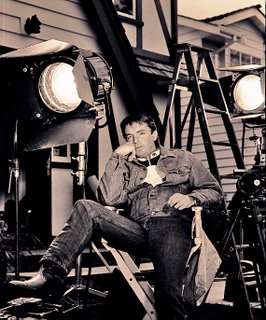
It was 21 Jump Street that brought to the world's attention Johnny Depp's good looks and acting abilities.
In that third shoot with Cannell (at the then Meridien Hotel)he told us (Les Wismeman was the writer)how fascinated he was with Dashiell Hammett and Raymond Chandler. He was thinkig about writing similar novels some day.
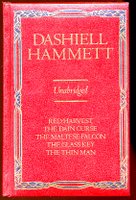
While I had read all of Hammett's and Chandler's novels at that time it was Cannell that explained that Hammett's titled Red Harvest had at all to do with all the blood that is spilled in the story!
I must confess that I have never read any of Cannell's novels but perhaps I should give one a try.
I remember Cannell most fondly from his story back in the early 80s at the Banff TV Film Festival where he told us at a lecture the story of the man who came to him with an idea. He had made a concerted effort to see Cannell and finally Cannell relented to get the man off his back. The man entered Cannell's office and said, "I have a great idea. It would be a TV series featuring a basketball team of one-legged men." Cannell, with a straight face said, "Continue." "That's it," the man said, "Isn't that a great idea?" It took a while for Cannell to explain that you needed more that an original premise to write a TV program. He then threw the man out.
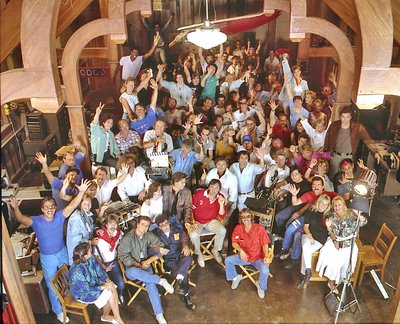
The man in the centre in red with white pants is Patrick Hasburgh. To his right, in the brown leather jacket is Johnny Depp.
Prince Of Foxes - Not
Monday, May 21, 2007

Cesare Borgia, Duke of Valentinois and Romagna, rose slowly from his chair, and slowly crossed to the window of that spacious chamber in the Rocca of Imola. He stood there in the autumn sunshine gazing down upon the tented meadow and the river beyond, and upon the long ribbon of road, the ancient via Aemilia, stretching smooth and straight with never a crease until it was lost in the distant hazy pile that was Faenza.
He was in the very flower of his youth; some seven and twenty years of age; tall, straight and lithe as steel. His father, Pope Alexander VI, had been accounted in early life the handsommest man of his day; of beauty and of countenance, it was said that acted upon women as the lodestone upon iron. - which had by no means helped him to the virtuous course that should be looked for in a church-man. That beauty Cesare had inherited, but refined and glorified by the graces of Madonna Vanozz de'Catanei, the Roman lady who had been his mother.
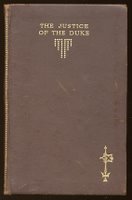
If there was sensuality in the full lips of the red mouth, half-hiden by the silky tawny beard, this was corrected by the loftiness of the pale brow; the nose delicately arched, the nostrils sensitive, and the eyes - who shall describe the glory of those hazel eyes? Who shall read their message, who shall depict the will, the intellect, the dreamy wistfulness, the impasiveness that looks out of them?
He was dressed from head to foot in black; but through the slashings of his velvet doublet gleamed the rich yellow of an undervest of cloth-of-gold; a ruby-studded girdle gripped his loins, and on his hip hung a heavy gold-gilted Pistoja dagger in a golden sheath of cunning workmanship. His tawny head was bare.
The Justice of the Duke
1912 - Rafael Sabatini
---------------------------------------------------------------------------------------------------------------------------------
That description of Cesare Borgia matches in every way Orson Welles's appearance and performance in my favourite cloak and dagger film of all time, Prince of Foxes.
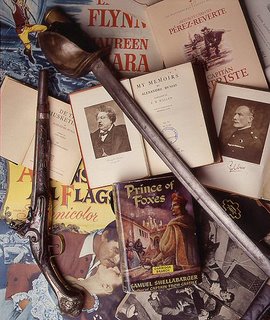
I have written here before of an experience I had about 29 years ago from my counter job at Tilden Rent A Car one winter Sunday afternoon. I was on Alberni Street and across was the moribund Ritz Hotel. On a Sunday, in those days, our downtown was as a quiet as a ship-of-the-line in the doldrums. There were two parked cars and the owners had switched on the four-way flashers. I watched how in some apparently unpredictable intervals the flashers of both cars coincided. It was then that I equated this phenomenon with that rare human relationship between two persons when everything seems to be right, if only for a while. I remembered enough of my school math to figure out that the mathematical formula that would predict a coincidence (the cars, who knows about people) would involve a couple of sine waves in phase.
For about 5 years my relationship with my granddaughter Rebecca (now 9) has been that rare "Ritzian Sine Wave Coincidence". We have hit it off in just about everything: from photography to gardening, from music to dance. But those two sine waves seem to be now out of phase.
Part of the problem could be the unstopable influence of television and my inability of preventing her from watching it when she comes to visit us on Saturdays (and this week end, Sunday, too). She watches that program with the boy twins who live in a Ritzy New York City hotel, Hilary Duff's program (before she grew up) and those terrible programs featuring terrible scenes of poverty in Africa, Mexico and Central America where Canadian celebrities like Karen Kane make you feel guilty enough that you get up to send a check in the mail that same day.
30 years ago when I was teaching high school in Mexico City it was fashionable to explain that teen agers did everything in 30 minute intervals. 30 minutes represented Stephen J. Cannell's "three act play method". In 30 minutes a hero was introduced, a conflict with a villain came in within minutes and by the end of the half hour a resolution was found. This meant that when dad convinced Jr. to help him paint a room, Jr. would throw in the brush after 30 minutes.
It was about 30 minutes into Henry King's 1949 Prince of Foxes (with Tyrone Power, Orson Welles and the inimitable Felix Aylmer) that Rebecca got up and disappeared. I put the DVD machine on pause and after a few minutes I knew Rebecca was not going to return.
I first saw Prince of Foxes when I was 9 so I thought Rebecca might warm up to it. My friend Paul Leisz says children are different now. I wonder exactly how. I had been saving with interest and special affection the day that Rebecca and I would sit down to see Gary Cooper in Beau Geste. It would seem, if Paul Leisz is right that Rebecca just might be and adult by then.
I told Rebecca to turn off the TV, earlier in the day. She shouted at me and threw some warmed up (in the microwave) tortillas. I lost my temper, too and threw the Sony remote on the floor. It shattered.
A few minutes later I had somehow put all the pieces back and the remote worked. I wonder if I should have kicked in the screen? The whole day was a strange one. Walking down the path by our pond with a rake in hand, Lauren (4) asked me, "What the hell are you doing?"
It was with relief and comfort that in the evening I finished Prince of Foxes, and in spite of the boilng oil being thrown down the ramparts of Citta' del Monte on Cesare Borgia's sceaming soldiers all was well with the world.
And this afternoon by a strange coincidence (as it rained outside) I enjoyed Robert Taylor and Kay Kendall in the Technicolor film Quentin Durward based on Walter Schott's novel. Would Rebecca have enjoyed it?
Joanne Dahl - Yielding Flesh
Sunday, May 20, 2007

I used to mix corn starch with the white wine in my cheese fondue so it would not curdle. I used to make sure that my bowl, whisk and ingredients, including the eggs, were at the same temperature when I made mayonnaise. A few years back, I began to ignore it all. The fondue never curdles and the oil never separates from the egg yolks. It would seem that in cooking like in English, as Winston Churchill allegedly once said, one has to learn the rules in order to break them.
The same applies to photography. And I have noticed other similarities with cooking. I have learned to understand that photography is much like being a cook for an evening dinner in which the cook does not know how many are coming or if there are any vegetarians or Kosher Jews in the mix. One has to be prepared for everything. My photographic palette is like a recipe book. I pull out the one that will function with the circumstances that apply.
My photographic recipe book is made up of recipes that I have discovered with years of experimentation. In some cases as in these pictures, they were never used or even liked (by my subject) but nonetheless, I learned something from the experience. I used fast colour slide film (Ektachrome 800) which I pushed and exposed with no flash. The photographs might have been improved if I had used reflectors on the dark side to diminish the contrast. But then I had to learn my lesson.

These pictures are at least 23 years old and at the time I was interested (as most younger men might) in why erotic photographs were erotic. I may have even taken these studies to show that beautiful cleavage had nothing to do with breast size. I do believe that is true but that is not earth shaking knowledge now for me as it might have been then. I do remember calling up Joanne and asking her what was erotic.
Her reply was short, "Yielding flesh."
The First Rose - Rosa 'Blanc Double de Coubert'
Saturday, May 19, 2007
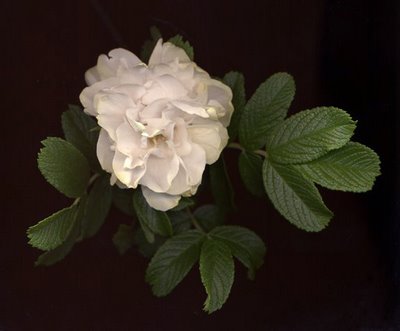
The two Maries were not taken to a ball until they were sixteen years of age, and then only four times a year in special houses. They were not allowed to leave their mother's side without instructions as to their behavior with their partners; and so severe were those instructions that they dared say only yes or no during a dance. The eye of the countess never left them, and she seemed to know from the mere movement of their lips the words they uttered. Even the ball- dresses of these poor little things were piously irreproachable; their muslin gowns came up to their chins with an endless number of thick ruches, and the sleeves came down to their wrists. Swathing in this way their natural charms, this costume gave them a vague resemblance to Egyptian hermae; though from these blocks of muslin rose enchanting little heads of tender melancholy. They felt themselves the objects of pity, and inwardly resented it. What woman, however innocent, does not desire to excite envy?
A Daughter of Eve (Chapter 1)
by Honoré de Balzac
--------------------------------------------------------------------------------------------------------------------------------
The first rose of the season in our garden (and I almost missed it) was Rosa 'Blanc Double de Coubert'. I didn't miss it because of its scent which is exactly like my mother's old Pond's Cold Cream. That first flower (there are over 25 buds) opened on Thursday and by the time I scanned it yesterday in the afternoon it was past its prime and the edges of this startlingly white rose were yellowish. But I like it as it is, reminiscent of my favourite flower that of the Magnolia grandiflora. I have been patiently waiting for Magnolia grandiflora to bloom since I planted the tree 12 years ago. Both flowers are equally fragrant if different in fragrance.
Blanc Double de Coubert, sometimes called the muslin rose, came to my garden as an accident 18 years ago when I bought her in a North Vancouver nursery off Mountain Highway. I lost the label soon after and forgot about it. One day I noticed this tall bush with strange foliage. I had to look the rose up and once it bloomed I knew I had a hybrid rugosa. Rugosa roses are extremely hardy (Zone 3) as they originate in eastern Siberia, northern China, Korea and Japan. Rugosa refers to the beautifully crinkled leaves. What is special and extraordinary about rugosas (most are extremely fragrant and have very nice hips, except for Blanc Double de Coubert) is that they are disease free and actually resent being sprayed with anything. They are remontant, which means that they bloom most summer and into fall. For potential rose gardeners who may be intimidated by the apparent complexity of rose pruning, Blanc Double de Coubert is never pruned. I leave it alone.
My Blanc Double de Coubert is also shade tolerant. At 11 ft high she is tall and elegant. 19th century British gardener Gertrude Jekyll (rhymes with treacle) wrote that Blanc Double de Coubert was the whitest white of any flower. I would argue that the white (and also fragrant) flowers of my Hosta plantaginea are as white. By coincidence Hosta plantaginea is the only species hosta with fragrant flowers.
Blanc Double de Coubert was hybridized in 1892 by Frenchman Cochet-Cochet who lived in Coubert. He said it was a cross between the species rose Rosa rugosa and the tea rose Rosa 'Sombreil'. Nobody really believed him and most suspect that Blanc Double de Coubert might be a sport (mutation) of Rosa rugosa 'Alba'.
As I scanned my first rose yesterday its perfume filled my living room. That perfume reminds me that late May may be the best month in the garden. You can notice how plants grow from one day to the next. My hostas have no slug holes and look pristine. The buds of my roses will soon fulfill their promise.

But Blanc Double de Coubert has one "flaw". Like all rugosas its stems have extremly thin and sharp spines. If you don't handle this rose with gloves the spines get into your fingers and break off. They are extremely painful.
The Ramans Do Everything In Threes
Friday, May 18, 2007
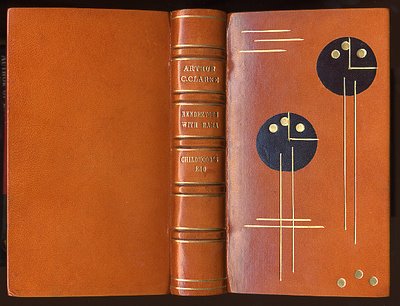
My Tía Fermina 95, lies very sick in a Houston hospital. She has a degenerated mitral valve in her heart that has precipitated a double pneumonia. She is too old for an operation and the medication to control the failed valve is not working. Her family called in the priest who gave her Communion and Extreme Unction. He jokingly told her that if she waited for another five years the statute of limitations on the sacrament (not true!) would enable him to return and give her the holy oils again. This seemed to perk her up and while she had had a doughnut for breakfast yesterday morning by lunch time she was demanding food from her favourite Vietnamese restaurant. Food with my aunt has always been the indicator of her health. It was on Wednesday that one of her daughters, Chayo had written to me, "Unfortunately since Thursday of last week she started sleeping a lot and not eating, not even chocolates!!!!"
I was able to talk to her yesterday. She was deaf so our conversation was one-sided. She floored me when she told me that we were in her prayers specially now.
It made me think of my mother was was nickanamed Sarah Bernhardt because she over-acted her health troubles. We thought she was hypochondriac. But in the late 50s she was diagnosed with Meniere's (I believe it is still incurable) which attacks the inner ears. It begins with loud buzzing sounds that destroy the body's balance mechanism so that one is constantly dizzy with almost a constant nausea. And yo become deaf in spite and because of the loud ringing in the ears. By the late 60s my mother was in despair and she confessed to me that she was losing her faith in a God that interceded in human affairs. He was aloof and thus prayer had no value. I was hard-pressed to convince her that she was wrong.
The reason is that my loss of faith had been precipitated by Arthur C. Clarke's science fiction novel, A Rendezvous With Rama. A huge craft is detected approaching the solar system.

It parks outside and then approaches the Sun. Earthlings investigate the craft but find nothing of the would be pilots. They find out that the craft, on its way to somewhere else, has "gassed up" with hydrogen from our sun. We humans are no more important that a gnat. The novel left me with a feeling that may have been the same one when Copernicus revealed to his world that the earth was not the centre of the universe and that the sun did not orbit the earth but the other way around. My mother showed no surprise when I told her of the book.
In the early 70s I had Rendezvous With Rama bound together with that other favourite Clarke novel Childhood's End. The French book binder Millioud had a shop in Mexico City and his work was legendary. He never scoffed at the idea of binding my cheap pocket books. When he returned this book he told me it was his interpretaion of Clarke's novel. It did not register on me at all and I just mentioned how lovely the cover was. It was only this morning that I caught on. Millioud must have at least read the last few sentences of Rendezvous:
And on far-off Earth, Dr. Carlisle Perera had as yet told no one of how he had wakened from a restless sleep with the message from his subconscious echoing in his brain:
The Ramans do everything in threes.
--------------------------------------------------------------------------------------------------------------------------------
Tía Fermina is better today and her daughter Carmencita is now worrying of the problem of finding an extended care facility for her. I warrant that the priest will not be called for another five years.
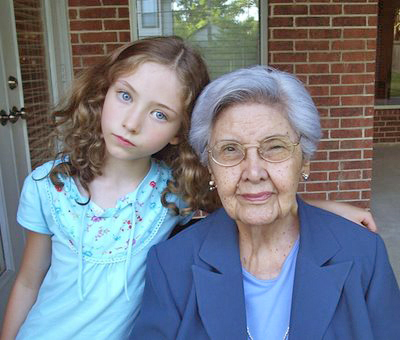
Here is Tia Fermina with Rebecca. I took this photograph last year when we visited her in Houston on our way back from Morelia. I think we need her to keep praying for us.
Hers & Mine
Thursday, May 17, 2007

A garden without tools would never be much of a garden. In our 21 years of gardening at our Athlone home, Rosemary and I have spent lots of money on tools, some useful and some useless, some that didn't work, plus a small fortune on all kinds of spades whose handles I managed to break just about every year. In one case I broke the stainless steel blade.
Yesterday I paid $36 (a bargain) on a spade at Lee Valley Tools that comes with a lifetime guarantee. A good spade is absolutely necessary if you transplant big hostas or move roses the way Rosemary and I do. Whenever we make a final decision on where a plant should be, it doesn't take long before we change our mind. I have had the idea of mounting wheels on some of my big hostas and then I would move them around without a problem.
For years I had been eying my Hosta 'Green Fountain' noticing it was in the wrong place. This plant has longish dark green leaves that cascade down. In the hosta bed with hostas that are vase-like, that are able to compete with agressive Osmunda regalis (Royal Ferns) and large clumps of white astilbes, this potentially beautiful plant was at a disadvantage. So yesterday with my new spade I took it out of the ground and put it into a big pot. I placed the pot on a pedestal in the back of my hosta bed. Alas, Green Fountain collapsed on the spot.
But this morning it was all up again and I felt happy I had purchased the new spade to replace the "very good" one I broke last week.
There is one tool that I have had for many years (a birthday present from Rosemary) and I would never think of going into the garden without it in my back pocket. These are my Swiss-made secateurs. They are a top of the line model that have a revolving handle to ease the strain on the hand when one is at it all day. These clippers I use to remove the leaves that might have black spot in my roses. I use it to prune the roses and all the rest of the bushes in my garden. I use them for jobs they were not intended to perform such as removing weeds from the lawn. I plunge the secateurs into the ground and twist around the ofending weed and pull out.
Some years ago I learned to use a thick leather glove in my left hand. One morning I had noticed that my secateurs needed sharpening but I decided to skip the operation. I was cutting some branches (so as to then mulch them with more ease) while talking to Rosemary. I almost severed my thumb except for factors. The unsharpened blade (one important factor) met the resistance of my thumb nail. I bled a lot and learned my lesson.
You see here our two Felco secateurs. Hers and mine. Hers are a bit rusty as Rosemary tends to leave them out in the rain and I have to bring them in. But she did point out a week ago when she used my pair, "Yours don't cut as well as mine do." I am so glad that is true.
Kimberly Holcomb
Wednesday, May 16, 2007

Kimberly was the kind of woman who would look at you in the eye and ask you, "Are you happy?" right out of the blue. It was unsettling.

So was her face. After looking at these negatives I remembered that she was a bit ashamed of her manly hands. Looking at them here I think they are beautiful and no doubt that they are strong, too.
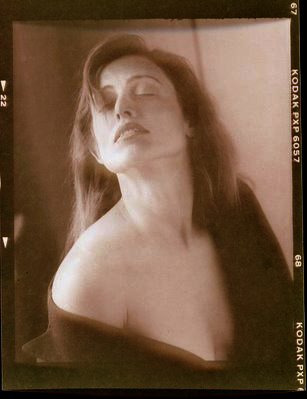

A Study in Blue
Tuesday, May 15, 2007

Just about everybody remembers Newton's experiment with white light shining through a prism and fracturing to red, orange, yellow, green, blue indigo and violet. Few today know that panchromatic b+w film, colour film, video and digital sensors, while sensitive to those colours, are sensitive with a shift towards the blue. Humans shift towards the red which is why red is so much more visible to us and fire engines are red except in Surrey, BC where they are lime green/yellow. This is why people argue about turquoise. Some will swear it is more blue others will say it is more green. We can always agree on red but with the blues there will always be doubts.
In the plant kingdom few flowers are a true blue. Blue hosta leaves are bluer to cameras, be they digital or film because blue hosta leaves reflect lots of ultra violet a colour that we humans cannot see. And since blue hostas are usually in the shade, there is more blue light (and UV) in the shade. Many blue flowers that we think are blue photograph as lilac or violet. Perhaps one of the only really blue flowers is the blue Himalayan poppy, Meconopsis grandis or Meconopsis betonicifolia.
This incredibly difficult plant to grow (it loves dappled shade, rich and acid moist soil all features of Vancouver gardens yet.....) was introduced to Vancouver by our Blue Poppy Lady A.K.A Marion McDonnell.
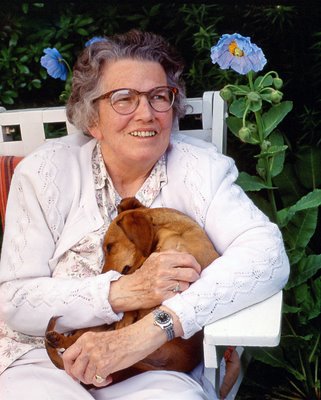
She was a most welcome fixture at the mostly rainy yearly VanDusen plant sales where in her plastic rain bonnet she would hand eager (and overly optimistic gardeners) her blue poppies which she grew from seed. Depending on the day she would either say they were Meconopsis grandis or Meconopsis betonicifolia. I failed to ever have one of my many plants repeat from one year to another. Here you can see Marion Mcdonnell in her garden with her beloved poppies and her Gretchen.
Her good friend "Cookie", A.K.A. Alleyne Cook picked his "bluest" Rhododendron augustinii and named it as the cultivar ( a selected plant from a garden) Rhododendron augustinii 'Marion McDonnell'. By strict botanical nomenclature rules this cultivar would then be called only Rhododendron 'Marion McDonnell'.
Last week I photographed Rebecca in front of my Rhododendron augustinii 'Marion McDonnell' and as you can see that while it is very beautiful it is not really blue. It is located not far from where I photographed Rebecca a few years ago holding the flower of Hydrangea macrophylla 'Blue Wave' which really is blue to the eye but not as blue to film.

Indiana Luna - Supreme Elegance
Monday, May 14, 2007

Indiana is close to 6ft tall and for a while she was my tango partner. Nobody ever seemed to want to dance with her because she was so tall. But I had noticed a couple of advantages. She liked to dress in black with black pumps and dresses that had slits in the right places. When I danced with her nobody seemed to notice me (that was just fine). Because of her height, and in order to dance Argentine tango style, which means awfully close, I had to rest my head on her chest. If you consider that Argentine tango is the only dance form where you might be slapped for not dancing close enough you can imagine the benefits of dancing with Indiana.
The first time I met her, at a Latin Dance Café she introduced me to her husband and minutes later to a woman who was wearing an exquisite slicked back short haircut. This was her wife.
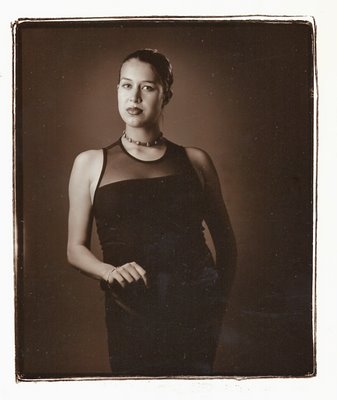
I mentioned to Indiana that in Canada it was called bigamy but she only shrugged it off with a laugh.
Two days before having her first baby, Indiana came to my studio and posed for me. She brought her black tango outfit.
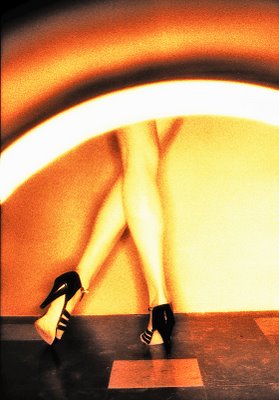
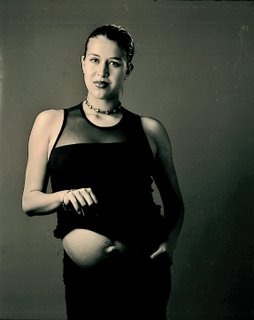
The Love Of A Mother
Sunday, May 13, 2007
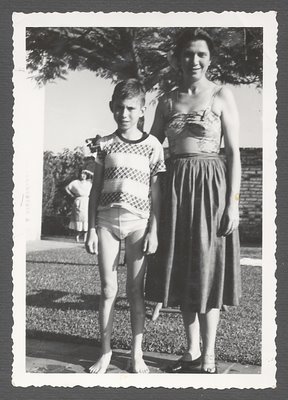
My mother often told me, "You will never understand because you will never be a mother." While I never felt (as a young boy) that I was a girl confined to eternity in a boy's body, my mother did make me curious as to what I may have been missing or avoiding.
She told me that love was doing and giving more than kisses and hugs. She sacrificed most of her life to sending me to good schools and satisfying my expensive tastes for smuggled Erector sets. Even when we could not afford it we had lots of the best food at the table. But she did mention to me a few times that I was "arisco". This is a Spanish word (that came via the Portuguese and the gallegos of northwestern Spain and has as its etymology the word arsenic) that really has no proper translation. The word is used to describe animals (specially horses) of unpredictable nature whom you would not pet (or in the case of a horse not ride). I can only hold my female cat Plata for about 25 seconds. After that she will scratch. She is "arisca" and will sleep on top of me during the night only because she chooses to do so.
My mother was never able to understand why I showered my father with kisses and hugs but kept my disance from her. I regret to admit that I may have told her that, "love could not be forced."
In 1954 my mother, my grandmother and I moved to Mexico. My grandmother had previously told me that I had to choose between my father and my mother. I was quick to answer (I was 11) that I wanted to stay in Buenos Aires. All the questionable legal proceedings to take me out of the country without the necessary persmission of my father were taken and we arrived 19 July, 1954 in Mexico City.
I returned to Argentina in 1965 to comply with my obligatory conscription in the Argentine armed forces. Both my mother and I knew (but we never talked about it) that I was returning to search for my father. Shortly after I left she wrote me a poem, "Ruegos" which loosely translates as pleas.
México Sept 1, 1965
Alex
Ruegos
Puede ser que vuelvas,
Puede ser que no
Pero quiero que sepas
que aquí estaré esperando
noticias de ti
De vez en cuando.
Te deseo lo mejor
que la vida pueda brindarte
una carrera brillante
Una mujer para amarte
Como tu te mereces.
Por todo esto - hago preces.
Hijo mío, que Dios te bendiga
Que la Virgencita te proteja
Para que siempre te conserves
Bueno, ecuánime, integro
Todo esto y mucho más te deseo.
F.I.G. (Filomena de Irureta Goyena)
In the poem my mother had doubts that I would return. But I did return a year later (while still in the Argentine Navy) as I had managed to get free passage in an American C-130 Hercules to Panama and from there I wangled passage to Mexico City. In the picture here with my mother I am wearing an Argentine bespoke three piece flannel suit and I have my short military haircut.
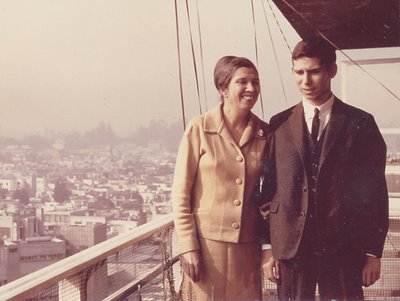
My mother may have been surprised to see me. But it was then that she told me something that I have treasured since with mixed emotion.
"As a mother I have always loved you because a mother has no choice. But I never did like you. Somehow you have changed and I like you now."
I think that is when we became friends.
Waltzing In With Style
Saturday, May 12, 2007

In July 1987 writer John Lekich wrote in Western Living:
While I've never felt the slightest desire to own a bar, I've always longed for a bar to call my own. This distinction is based on the premise that even saloon keepers in the most enviable situations - say Humphrey Bogart toasting a misty-eyed Ingrid Bergman at Rick's Café Américanin - end up checking the glasses for spots. Patrons, on the other hand, have a different obligation. If you're a patron, all you have to do is waltz into your establishment of choice, slide into a reserved booth and bark,"I'll have the usual, Al." (All bartenders should be named Al.) If you're a regular, you won't ever have to worry about Al sucking in his paunch and pulling out a Louisville Slugger.
Not long after this article appeared I remember looking at myself in a mirror while adjusting my bow tie. I was wearing a light blue Brooks Brother's button down shirt. Something looked odd. So I called John. His advice was short, "Don't."
In an age where anything goes (try opening night at the Vancouver Opera) I find comfort in knowing that a few people keep up with standards even if Baron Lee and his establishment of proper dress are gone.

In my profession of photography not too many people care how I dress as long as I can provide an image with a proper exposure. This means that I buy two pair of blue jeans and two black at Mark's Work Warehouse every couple of years. A few of their mock neck blue or black cotton shirts and boxer shorts at Simpson Sears complete my fashion needs. I wear my one suit to the opera until (inevitably) it's small and that's when I make a visit to the Bay.
But I must admit that my sense of fashion isn't all dead. When I take Rebecca to dance or a concert I ask her mother, "Make sure she is dressed to the teeth." I would have never suspected that as an adult man dressing up a doll I would find it as satisfying as knowing you never wear bow ties with a button down shirt. I am sure that Lekich would understand.
Model Protocol
Friday, May 11, 2007
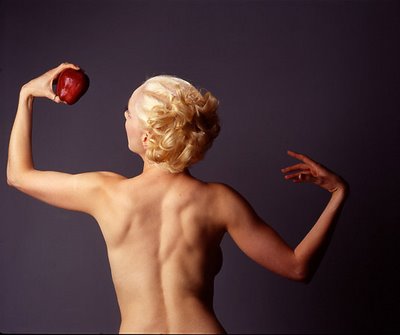
When I woke up today I remembered that May is the best month in the garden. This is the time when my hostas grow many inches overnight. You can see the change from one day to the next. The slugs and other pests have yet to do their damage and the plants look fresh, green and luscious. I also remembered that after months of nagging by my full-time-term students at Focal Point I am giving them what they wanted. This means that aroun 18 of them will feast their eyes (or will they do this in the sly?) on our two models (one male, one female) as we proceed with the nude portrait (that's what I call the course)class today for three hours. For many it will be a right of passage as they have not photographed nudes before. Even though I have done this for many years, the prospect of having a couple of brand new models for me is always like an early morning in the garden in May.
To make sure that the class goes smoothly I always distribute (a week before) what I call the model protocol to both my students and the models.
The Nude Portrait
Spring 2007
Alex Waterhouse-Hayward
Model Protocol
About 23 years ago I photographed around 9 exotic dancers dressed as London Bobbies (cops). The resulting photograph was framed and was placed inside the Cecil Hotel. It may still be there next to the pool table. The photo imitated a large mural/painting of 9 Bobbies that at the time graced the wall of the hotel. When the women arrived to the warehouse where I took the pictures (a white brick wall was needed) they asked me where they could change. I had set up an area with a large sheet where they could do this. My assistant commented, “Why would they need a place to change. They are strippers, aren’t they? “
It is obvious that my assistant was horribly wrong and no further explanation is needed.
But some of us, particularly, when we are behind the camera forget that the person who is our photographic subject is a person, and to be repetitive, a human being. I am sure that my assistant had objectified the exotic dancers and it never occurred to him that they were women who valued their modesty and privacy when not working at their job.
A variant of being aware that our subject is a person should be our ability to put ourselves in their position. While we may not want to pose now or in the future either clothed or unclothed we should think, “Would I do this?” “Would I do it like this?” Why am I telling the model to relax? Could I do it (relax) if I were facing that camera and that big soft box?”
Models, even very good models cannot predict what a photographer may want. They can do this if they have worked with you before. You cannot expect them to do something while you wait to snap your shutter unless you give them the proper and courteous indication. Saying, “Please”, and, “Thank you, “is appreciated. If you cannot verbally explain the pose you want, you can step in (don’t touch!) and show the model how. My advice is to watch your models when they are relaxing during their rest periods as they will do things that come naturally.
You should not only provide your model for an area to change where they have privacy but you should also expect them to clothe themselves (there are a few that don’t!) when they are not posing for you. A cooling fan on hot days and a heater on cold days is most necessary. An area where the model has a mirror and a stool with table where they can apply makeup is nice to have.
It is my personal rule that I never touch my models, particularly when they are unclothed. The exception can be a stray hair that may cover an eye and I will sometimes use my pinky finger to move it out of the way.
Looking at your model, when not through the camera, should not be an obvious stare. Learn the way doctors do it. You look at them at eye level. Until you know your model well and you know about their sense of humour, or lack of it, you should never make any jokes about their body.
When I photograph anybody, clothed or unclothed, I don’t point out their physical demerits. If their face is too wide I narrow it with lighting. You don’t say, “You have a chubby face.” If the model has stretch marks you find angles where they don’t show. Unless your model wants you to document their body as it is (this rarely happens) it is your duty to make them look as good as you can and not blame your lack of lighting skills, bad equipment, or their body for your unsatisfactory picture. Unless you are really very good with PhotoShop, a Polaroid or the image on your screen will never look that much better.
In our class we should take as perfect a picture seconds before we press that shutter, be it film or digital.
Again I want to stress that you must respect a model’s privacy in the way you may show the pictures that you have taken. They should be seen only in your hard copy (as in one of those black books with plastic sleeves) and none of your photos should be posted on any web page be it a personal one or another type. If you wish to do this you must get permission in writing from your model.
Any model, and particularly the unclothed one, is in a vulnerable position when they face your camera. They trust you. Some models (if not most) will object to showing parts of their anatomy that they deem to be extremely private. When they pose for you, you may be in a situation to be able to photograph what the model does not want to show. It is your duty to move them until the pose is a correct one.
In the end it is more difficult to not show the external sexual organs of a male model. Male models will have different requests to that of female models. In our class sessions we will bring this up. In your own sessions, out of school with other models or friends, you should always bring up this sensitive area before you begin to shoot.
I always prefer to shoot without any kind of music, unless my model specifically requests it. I like to work in silence. The idea that the young thing in a bikini will remove her clothes, just because you offered her wine and play loud heavy metal music, only works on planet Jupiter. From the beginning you tell your model where the bathroom is and you should have plenty of bottled water. Alcohol always shows up on your model’s face and pot makes their eyes go red. And the last, often overlooked, recommendation is that models like to be given positive feedback on how they look in front of your camera and how they are taking to your instructions. Give them plenty of this stuff. They will warm up to it.
CBC Group Show
Thursday, May 10, 2007

From the very beginning that I happened to pick up an issue of American Heritage in the Lincoln Library (a USIS facility full of spooks) in Buenos Aires in 1952 I was drawn to the pictures of long dead American Civil War soldiers in photographs by Timothy O'Sullivan and Mathew Brady. That single issue of American Heritage is why I am a photographer today. As a ten year old I realized I was looking at people who were alive when the picture was taken but somehow they were now all impossibly dead. Through the years I have had a particular fondness for shooting group shots. As the photograph gets older and my memory for the names of the people in the shots fades the photographs seem to be that more interesting. And here is a bunch that I took in the 70s and 80s in Studio 40 of the CBC on Hamilton Street.
The b+w one was of the CBC TV News team. I particularly remember Ann Petrie (being held and to the right of Bill Good).
The next group shot I am not sure, but the set is extremely colorful. I often wondered why those CBC set designers loved lit steps. Smack in the middle in the light blue sweater is Michael Watt and to his left is choreographer and dancer James Hibbard.

The René Simard one is self-evident. I fondly remember Joanie Taylor for her wonderful voice and her Sphinx hair do (extreme right in picture below).

Working for these shows was fun because working for the producer (in most cases Ken Gibson and his right hand man Michael Watt) was fun. In particular it was fun to work with Gibson's Irish Rovers here in the Unicorn Pub group shot.
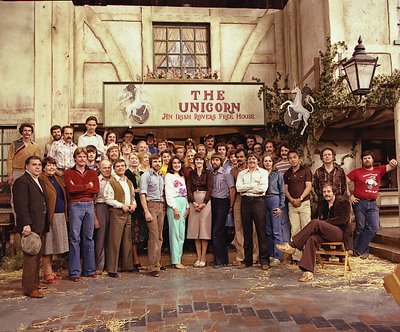
One of the shows, Boo, was a spoof of horror movies. What I remember best is this group shot of the dancers. The one in the middle was the daughter of the then ex-Vancouver Police Chief, Robert Stewart. We were all in awe of her legs.
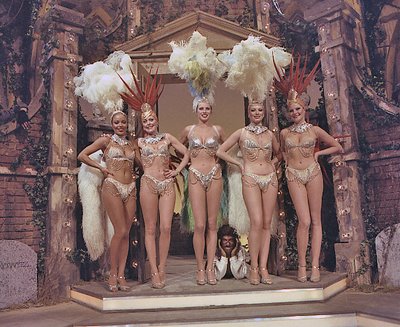
But it is the last shot that somehow never saw the light of day that is my favourite. In the early 80s brainy comedian David Steinberg had a TV comedy show. In one very special day he invited as many comedians as he could find and asked me to take this group shot.

Middle row far right is Ryan Stiles. Two to his left is David Steinberg. I also recognize Jackson Davies, top left.
Rebecca's Improper Fractions
Wednesday, May 09, 2007
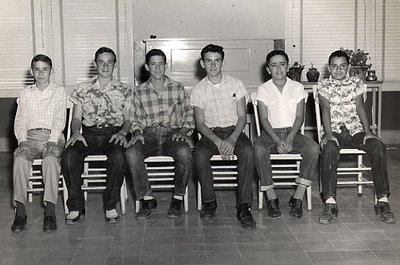
Last night Rosemary was glum. Hilary called her to tell her that Rebecca had scored poorly in her math test. Somehow Rebecca did not tell her mother about the test so nobody helped her to prepare. Rosemary feels very guilty and went to sleep early. Rebecca is 9. She is in grade four at École Bilingue.
No matter how tough it is for her at school it makes me think of me in grade 8 in a very small school in Nueva Rosita, Coahuila. Grade 8, 7 and 6 were under one roof and the teacher happened to be my mother.
We were in Nueva Rosita because my mother had a job as teacher for the children of the engineers who worked at the American Smelting and Refining Company mine. They mined zinc and converted coal to coke. The coke was shipped to the US to make steel.
It was tough because my mother was doubly hard on me. Grade 8 was as far as the Nueva Rosita school went and from there our class of 6 boys graduated (we were all given razors as a graduation gift from the school) and we dispersed to schools in the US.
I am on the left (the boy with the big ears). My nemesis was Sammy Simpson, third from left. He was smart, good looking, tall, could immitate Elvis Presley's Blue Suede Shoes (consider that this was 1957), he played baseball and basketball, was a champion bowler, and got to drive his parent's '57 Ford all the time. Worst of all, he wore crisp, faded just right, Lee jeans and mine never looked like his. My mother did not know how to iron well so I tried to get Sammy's razor creases to no avail.
My only comfort was that I knew I was smarter than he was. Until my mother somehow told me one day, "You have a very high IQ Alex but not as high as Sammy's." I was devastated. In the 50s there were two very important double initials. One was IQ and the other was SA which stood for sex appeal. Sammy had both and I had neither. I settled down to be a nerd. In high school I avoided school dances because I could not dance and I was ashamed of my big ears. When two women showed interest in me (I was by then 20) I thought they were idiots. I could not believe it!
If Rebecca had not been asleep last night I would have called her and told her that failing the math test wasn't important. I would have told her that she navigates her piano music math very well and knows all about the f-stops and shutter speeds of my manual cameras. She has an excellent idea of how much space her body occupies from her dance classes (ballet, jazz and character at Arts Umbrella) and is able to follow all the steps in correct order without any problem.
When we go to her piano lessons I always put a previously unheard piano CD in the car stereo. Last Monday we listened to Philip Glass playing his piano sonatas. Rebecca immediately caught on to possible similarites with Erik Satie.
Last Saturday before going to Sebastian Alexander's baptism I gave Rebecca a crash course in Original Sin and the seven sacraments. We delved into the doctrine of transubstantiation and the Holy Trinity.
I remember when I was in grade 9 and I could not do chin ups. One day I was able to do one and then another and soon they were easy. I think the same will happen with Rebecca as soon as she realizes some of the practical applications of math. I cannot blame her for not being interested or understanding what an improper fraction is. It was on improper fractions that Rebecca did poorly.
Hilary nor Rosemary like this picture that I took of Rebecca last Halloween. They say she looks too mature. For parents their children will always be children. Yet they worry about their child's school grades to the point that a child, in this case Rebecca, comes home, almost in tears and refuses to talk about her day. I understand as I remember what it was trying to compete with Sammy Simpson.
I think there is plenty of time (if ever) to worry about math and school grades. Meanwhile I remember:
You find it hard to forgive those who, early in life, have
come to enjoy the advantages which go with maturity. Aside
from any other consideration, why don't you put into the
balance the long spring enjoyed by a youth who matured
late.
Markings - Dag Mammarskjöld - 1964
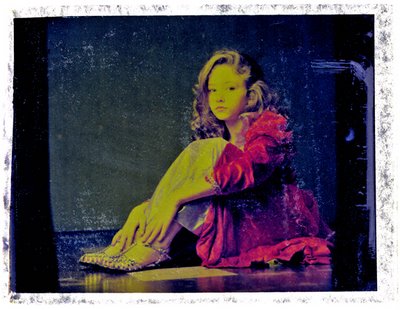
Rebecca and I will have to study a few Dave Brubeck Quartet pieces with that difficult 5/4 time signature. It's an improper fraction. And in Take Five it's an improper fraction that I am sure Rebecca will like.
For those who might want to know the names of the boys in the picture please look here
Two Coroners - One Never Smiled
Tuesday, May 08, 2007
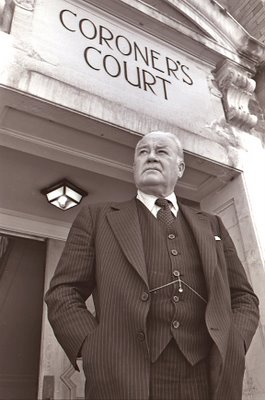
It was sometime in 1984 that I photographed retiring city Coroner Glen McDonald for Vancouver Magazine. A year later McDonald published a book (co-written with John Kirkwood) with the curious title How Come I'm Dead? Of the shoot I remember little except for a few things. McDonald smelled of whisky and even though he was very serious I had this impression that at any moment he was going to laugh loudly.
In October, 2002 I had the opportunity to photograph another city coroner, Larry Campbell. By then he was our mayor and he came to my studio with a collection of hats. Unlike his predecessor he smiled all the time but I managed to get this out of character photograph (or is it?) of Campbell looking very serious.

I find it curious that both men dealt with death yet had an uncommon liking for spirits.
Jim Carroll - Catholic Boy - Confirmation
Monday, May 07, 2007

They can't touch me now
I got every sacrament behind me:
I got baptism,
I got communion,
I got penance,
I got extreme unction
I've got confirmation
'Cause I'm a Catholic child
The blood ran red
The blood ran wild!
Now I'm a Catholic man
I put my tongue to the rail whenever I can.
From Catholic Boy - 1980
One of my fondest memories of my father is singing in bed with him. Our two favourite songs were My Bonnie Lies Over the Ocean and Onward Christian Soldiers. It is only recently that I found out that the latter song was originally called St Gertrude by Arthur Sullivan who wrote the music.
There we were singing as loud as we could:
Onward, Christian soldiers, marching as to war,
With the cross of Jesus going on before.
It was in 1980 that I photographed Jim Carroll and his band at the Commodore in Vancouver. I was struck by the lyrics of his title song (above) Catholic Boy. He misses two sacraments(Holy Orders and Matrimony) although he must have been at death's door in one of his drug ODs to receive Extreme Unction.
For many years, until it closed in 1989, I was a patron of the Classical Joint on Carrall Street. I went on Thursday nights to listen to my friend, alto saxophonist Gavin Walker play with his ever changing band. What never changed was the repertoire of classic bebop and bossa nova tunes peppered with jazz standards. There was one that intrigued me.

It was Charlie Parker's Confirmation. Walker explained that as a boy Parker had sung in a Catholic Church choir and that indeed the name of the tune was Catholic.
I would only mention that Confirmation is the forgotten sacrament. This is the sacrament that follows First Communion and makes one a "Soldier of Christ". As it was explained to me by Brother Edwin Reggio CSC this meant that it was my obligation to find out as much about the Catholic Church and its doctrine so that I could instruct anybody who asked. Brother Edwin saw Confirmation as an obligation to teach and impart and not something out of Arthur Sullivan which would have us march with sword in hand to battle the hoards of infidels!
Taking Confirmation seriously (and I was confirmed) has enabled me to explain to Rebecca all the questions she asks every time we enter a church in Mexico or in Vancouver. It will give her a richer appreciation of art, music, dance and the architecture of Gothic cathedrals.
And there has been an added bonus. I have been able to fend for myself when my Argentine nephew, Jorge O'Reilly (who is a member of Opus Dei) tries to put one over me!
Rebecca, Inesita & La Redonda
Sunday, May 06, 2007

Yesterday Rebecca, Lauren and I went to Sebastian Alexander Schallie's baptism at St Augustine's Catholic Church in Kerrisdale. The interesting ceremony was a complete Mass and I did my best to explain to Rebecca what was happening. I pointed out that to our left on the main altar we could see a stained glass window of St. Augustine and that we could tell it was he because of his bishop's hat. Immediately Rebecca asked me where St Monica's window was. I have told Rebecca often the story of the Bishop of Hippo(354-430 AD) who early in his life (when he was having lots of fun womanizing) prayed to God asking him, "Make me a saint, but not yet." And it was because he had been such a wicked man in his youth that his long suffering mother had been made into a saint. When we left the church I had a chat with Father Gordon Cook and asked him about Monica. It was then that I found that the church is named after another bishop, St. Augustine of Canterbury (birth date unknown but died 26 May, 604 AD) and there is no patient Monica in the premises.
Earlier in the day I had explained to Rebecca the Catholic concept of original sin and how baptism is the first sacrament of a total of 7. I explained how some Christian sects believe that sprinkling with water is not enough and total immersion is necessary. Shades of Achilles?
All this set me to thinking that as a youth my religion had been quantitative and not qualitative. Let me explain.
When I was 9 I would go to visit my cousin Robby Miranda who lived in Belgrano C in Buenos Aires. On Sundays we would walk to the nearby church on Juramento and Cabildo, la Parroquia de la Inmaculada Concepción but affectionately called La Redonda (the Round Church) because it indeed was round.

Robby and I would calculate to get to the Mass by the Offertory. At the time if you arrived a bit before the Offertory and stayed until the priest said, "Ite Missa Est," ("Go, the Mass is ended.") we would satisfy our contractual obligations to go to a complete Mass on Sunday. We then considered that on very hot days we stood outside the church's open doors and looked into the Mass. Did we have to be under the roof of the church to be in the Mass? We argued about this to exhaustion. We may have been too immersed in our discussion to notice that Father Virgilio Filippo (he was a great orator) usually insinuated in his sermon that unless we became good Peronists we would burn in hell.
So it was that four years ago when Rosemary, Rebecca and I went to Buenos Aires I felt I had the obligation to take Rebecca to La Redonda for Sunday Mass with my godmother and first cousin Inesita Barber O'Reilly Kuker (above left). This we did and we had a lot of fun. The officiating priest resembled matinee idol Cornel Wilde. I could almost imagine his foil hidden under his chasuble. From our seats, which were halfway down, (it was very hot but I did not think it was proper for me to suggest to Inesita that we step out!) Rebecca kept waiving at the priest. You would have thought that Inesita would have taken it all very seriously. But no, she thought it was all very funny and I heard her giggle. After the Mass we had medias lunas and café in the cafe outside and it was very special that my godmother could be sitting at the table with my granddaughter. I felt some sort of symmetrical order and that all the religious instruction I had received from my mother and grandmother (and Brother Edwin at St Edward's in Austin) I had passed on to Rebecca and that it would serve her well as it had served me.
The reason Inesita had been chosen as my godmother was that her mother, my Aunt Inés had divorced Barber to marry Alejandro Ariosa (which explains my middle name of Alejandro). So instead of my aunt being my official godmother (though se was de facto) her daughter Inesita took on the responsibilities of taking care of my spiritual life or helping in other ways in lieu of the absence of my parents. I must report that Inesita has been the perfect godmother in all respects.
Yesterday the priest's sermon at St. Augustine was a bit long and Rebecca asked me, " When is he going to shut up?" I confessed to her that we were participating in a complete Mass (thinking about what dispensation I would have looked for so many years ago that would have enabled me to avoid Mass on the next day, today Sunday.) and that we needed some patience. I explained to her the beautiful compactness of Latin and what Ite Missa Est meant. When the time came the father said, "The Mass is ended, go......" and I missed the rest because Rebecca at 9 had the same smile of relief that I myself must have had when I was 9 and Robby and I ran out of La Redonda to play rolling down on the grassy slopes of our favourite park, Barrancas de Belgrano and then buy a porción of pizza at the nearby Belgrano C train station restaurant.

Rebecca, at 9 is much too young for me to explain a further mystery about La Redonda and how it figures in the plot of my favourite Argentine novel, Ernesto Sábato's Sobre Héroes y Tumbas. This will happen, when like her grandfather, she shifts from the quantitative to the qualitative.
The Bishop of Hippo, Floria Aemilia & The Bitch
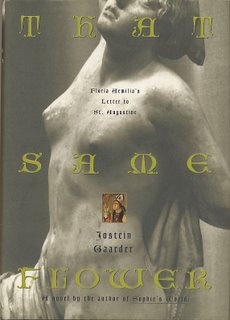
St. Augustine of Hippo and St. Thomas Aquinas are really the two most important saints of the Catholic Church in reference to doctrine. Aquinas modified and adapted Aristotle's concept of the unmoved mover as his "proof" of the existence of God. I always saw God as a very special bowling ball that somehow moved all the other bowling balls in a row (as they are automatically returned) without It moving at all. The three finger holes on the ball are sheer coincidence and have no bearing to the Holy Trinity.
I have told Rebecca the story of St Augustine thinking on the problem of the Holy Trinity while walking on a beach. "How could God be three distinct persons, the Father, the Son and the Holy Ghost and somehow all be (and certainly not share as that would be heresy) the nature of God?" He spotted a little boy (sometimes in my story he is naked) who was running to the sea with a sea shell where he would scoop some water and then run back to the sand where he had dug a little hole. He would then empty the shell into the hole and repeat his procedure. Thinking this a bit strange, Augustine stopped the boy and asked him what he was doing. "Sire, I am emptying the sea into the hole." "Child, that is clearly impossible," Augustine retorted. The little boy then said, "Far easier for me to finish my task than for you to find an answer to your problem." And then I tell Rebecca the little boy vanishes in a poof.
It was a few years ago in 1997 that I found a little book called That Same Flower by Norwegian author Jostein Gaarder. This book is a translation from the Latin into Norwegian and then into English by Ann Born. The book is supposed to be the letters that St Augustine's mistress, Flora Aemilia wrote to him.
How did Gaarder find the letters?
In 1995 Gaarder was browsing in an antiquarian bookshop in Buenos Aires' old district of San Telmo. It was there that Gaarder claims he found the letters in a box labeled Codex Floriae. Inside he found an introductory greeting:
Floria Aemilia Aurelio Augustino Episcopo Hipponiensi Salutem
We do know that Augustine did have a mistress called Floria who was the mother of his only son. They lived together for over a decade in Africa and then in Italy, until Augustine banished Floria with the intention of marrying a woman of higher social status. He never did and chose a path of asceticism.
From the book I copy:
You thought I bound you to the world of the senses, leaving you no peace and quiet in which to concentrate on the salvation of your soul. As a consequence, nothing came of that proposed marriage either. God desires above all that man should live in abstinence, you write. I have no faith in such a God........But why? Well, because you loved the salvation of your own soul more than you loved me. What times, Esteemed Bishop, what manners! (O tempora, o mores!)
The book is a delightful one night read and what is most interesting is that our concept of the terrible mother-in-law has not changed in the least with time. It seems that while Monica was a good mother and a saint she was a bitch.
Butterflies, Locusts, Fireflies & Pharaoh's Egypt
Saturday, May 05, 2007
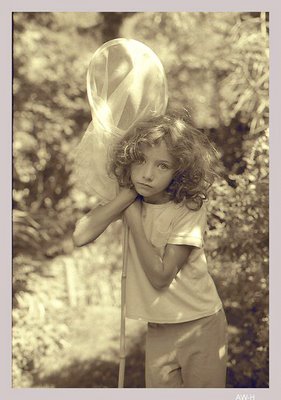
There were so many locusts in our Buenos Aires garden one year in my youth that we could barely see the blue sky. My mother and Mercedes, our housekeeper, banged pans with their lids in a futile effort to scare the large green monsters away. A few weeks later the sky was blotted out by waves and waves of white butterflies. The ten plagues of Egypt that finally convinced Pharaoh to release the Israelites were no simple bible tales that had been read to me at Sunday School. Our own plagues were my early dose of cinéma vérité.
Then there was the year that my mother almost burned down one of our huge palm trees. She was out at night hunting for slugs (with scissors) and held a candle in one hand to see. She got too close to the palm (Buenos Aires is a city of palms and jacarandás) that the dry peeling bark caught fire and it spread like a pirate gunpowder keg to the top in a flash. By the time the bomberos arrived the fire had gone out as quickly as it had begun. It was a miracle to me that the palm tree survived as our plum trees somehow survived the locusts.
Our garden had all matter of interesting insects and bugs. We had large black ants and large read ones that I avoided as they had a painful sting. We had four-inch-long rhinoceros beatles and at night in the summer, fireflies were in such abundance that we would sit in the garden to watch them while my father drank his mate and my mother her tea. I was given milk with a chocolate powder called Tody. I really liked it because Tody sponsored my weekly radio program, Tarzán (El Rey de la Jungla). My all-time favourite episode featured a totem pole (?) made of a mysterious substance called radium. I had cut out Tarzan's picture from the Tody container and glued it on my turtle's plastron (the under part of the carapace). It was this turtle that had a fondness for hybernating under a pile of fall leaves. One year my mother gave me permission to burn the leaf piles and......I remember crying to my mother, "I murdered my turtle!"
I spent a lot of time in the garden as there were several fruit trees to climb and sample including plum trees that had green plums (yellow on the inside), yellow plums (yellow on the inside) red plums (yellow on the inside), red plums (almost black on the inside) and a tree of special plums that were a cross with a cherry tree. When I wasn't sampling the plums I was waiting patiently for the níspero to ripen. I avoided the brevas (the early figs) and the figs that followed. When they splatted on the brick path they looked so unsightly that I developed a distaste for them. I hated the tree because its smooth bark discouraged my climbing. And one bite of an unripe persimon, from the tree my father insisted on calling the khaki, cured me from ever trying this fruit again.
Two summers ago I bought a used Nikon FM-2 from Leo's Camera and tested it with one roll. I snapped a few pictures of Rebecca and her butterfly/koy net by the rose bed in the waning days of that August summer. The exposure metre did not work so I returned the camera. Perhaps I should have kept it. This photograph is one of Rosemary's favourite photographs of our granddaughter.
While Rebecca did see Buenos Aires fireflies three summers ago I have yet to tell her about the ten plagues of Pharaoh's Egypt and the year of the butterflies and the locusts.
Frida Bertrani & Ross Weber's No More Monkeys Jumpin' On The Bed
Friday, May 04, 2007
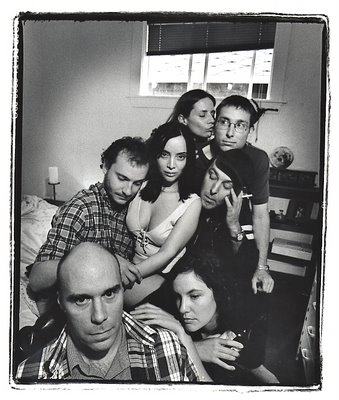
I had been looking for this photograph for a long time but I could not remember either the name of the movie or the director. So the photo lay buried in my files since I took it in September 2000. I had been assigned then to take a picture for the cover of the Straight (one of those now rare photographic covers) and the instructions were to make the picture look gritty like the movie.
It is no accident that the man (or woman) in charge of the camera work during the making of a movie is called the director of photography. When I met up with director Ross Weber and his cast of 6 actors at house in East Vancouver I felt a bit like a director of photography. I had fun arranging the actors in my frame.
Taking pictures of more than three people is very much like taking pictures of a rock band, which is no different from snapping one's family. I use the same technique to photograph a group of lawyer. The secret is to place the persons, one at at time in your location of choice. In this case it was a bed.

It was very difficult not to notice Frida Bertrani as seen here in the centre of the photo so I had to place director Ross Weber in the front to give him a better chance to stand out.
With digital cameras (the very expensive one) only now being able to expose at the extremely fast ISO (light sensitivity) of 3200 it is interesting to not that back in 2000 Ilford's Delta 3200 was a cutting edge film for medium format cameras like mine.
Nina Gouveia - Mano A Mano
Thursday, May 03, 2007

Some 12 years ago I received a phone call from Adrian du Plessis who wanted a favour. He had a friend who had the ambition of being a photographer and he wondered if I could help her. That is how I met Nina Gouveia who ended up being my Tina Modotti.

As a young teenager I had lived with my family on Avenida Tamaulipas in Mexico City, about two blocks from Avenida Yucatán where Edward Weston had taken a nude photograph of Tina Modotti (Tina on the Azotea) on the roof of the house he was renting in 1924. Only now do I understand the wonderful significance as I treasure Edward Weston's Daybooks. Through the years I have read them often and I was jealous of his bohemian existence and of being able to ask the beautiful Modotti to follow him up to the roof for some photographs.

Nina may have learned some photography from me but it all happened because she faced my camera and only rarely did we take photographs together. The first time, when she came to my studio we had a mano a mano with my camera. I would take a picture of her and then she would immediately take a picture of me until we exhausted a 20 exposure roll. Here are two from that series (the one with her upturned hat above). We also photographed her friend Bif a couple of times. In one of the sessions we used Toni Ricci's excellent penthouse in his Marble Arch Hotel (the Paris Hilton of our fair city) as seen, below.

Nina was quite short and darkish. She had been born in British Guiana and I always suspected her parents were gypsies because they moved a lot. Nina always looked ten years younger than she really was. I always made fun of her taste for big boots which always made her look even shorter.
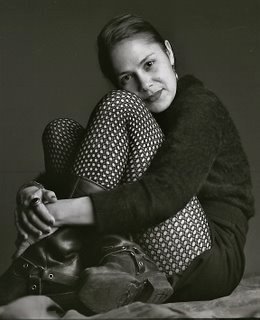
Because she was a yoga instructor she had tremendous flexibility and strength for posing and for keeping her poses.

Luckily I did realize from early on that she was a photographic treasure and I photographed her often but not as often as I would have wanted until she and her family picked up sticks and moved to Spain.
My friend, Argentine painter Juan Manuel Sanchez loved to work with Nina and we did several joint projects that we called "colaboraciones". He said that Nina was very "plástica" by which he meant her flexibility and tone. Nina not only posed in silence but she also had her own ideas.
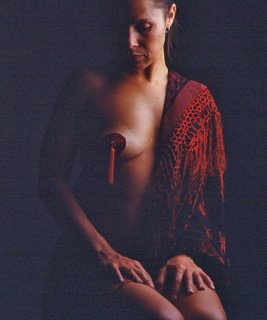
In one she wanted me to photograph her with a strippers's tassle. We also had great fun transforming her old apartment on Maine Street into a temporary 1940s Mexican house of ill repute just for an afternoon and just for my camera.
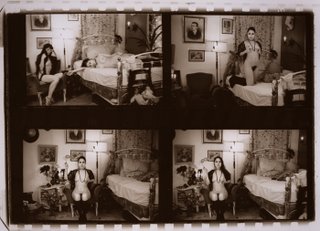
A Rose, A Bathtub & Sir Isaac Newton's Third Law Of Motion
Wednesday, May 02, 2007

I am not sure that learning how to diagram a sentence ever led to me seeing the light or to apply it to everyday living.
But I can safely say that there are two pieces of knowledge learned at school that I have been able to apply in a practical and useful manner. Both have some connection to water and to Sir Isaac Newton. Every couple of years I have to drain my fishpond. This used to be a messy job until I remembered that if I put a hose in the pond and sucked on the end and placed the hose in a lower part of the garden, the pool would drain by itself thanks to gravity. If I drained the pond on my rose bed I found that the pond water, rich in organic silt, gave me bigger and more plentiuful roses in May and June.
For years I have known how gravity affects the human body. Never more so than now when at age 64 I look at myself in the mirror. This means that I have known to never photograph a woman on her back as gravity pulls down and makes her look fat. But I accidentally learned that there was a happy exception and that you could place a woman on her back, as long as she was in a tub of water. This is a prime example that confirms Newton's Third Law of Motion that states formally:
For every action, there is an equal and opposite reaction.
Water in a tube gently pushes back (counteracting gravity) on a woman's body lifting any part of her body that just might sag!
Since I have been of late writing about roses here we have a photograph of Rose (I have long forgotten her last name) showing how Newton's Third Law works. As for Rose blowing into the water both Newton and competitor Huygens would have argued about the wave-particle duality.
Rosemary's Exclusive Talent
Tuesday, May 01, 2007

Rosemary has an exclusive talent for seeing beauty and garden worthiness in plants that I often not notice. A case in point is Lathrys vernus the spring flowering member of the pea (and sweet peas) family. The Royal Horticultural Society says of this plant:
These pretty, ground-hugging spring peas can be found to the right of the main track to the Fruit and Vegetable Garden, just after crossing the bridge over the stream. At a time of year when yellow flowers (daffodils, primroses, celandines) and blue flowers (bluebells, Anemone blanda, grape hyancinths) predominate, it is refreshing to come across an unusual plant with distinctively different colouring. Grown at Rosemoor for the first time in 2004, Lathyrus vernus proved to be very popular with our visitors.
Of the plant itself the RHS says:
This is a clump-forming, herbaceous perennial with upright, angular stems, mid- to dark-green leaves, with two to four pairs of sharp, pointed, pinnate leaflets, up to 8cm (3in) long.
The flowers are produced in short racemes of up to six flowers, 2cm (0.8in) in length, reddish-purple in colour and becoming shaded greenish-blue with age.
The plant may cause mild stomach upset if ingested.
Rosemary rapidly loses interest in the plants that make her excited and she shifts to her next find. When she noticed roses I thought she was crazy. She dragged me to boring meetings of the Vancouver Rose Society that featured slide shows of badly photographed roses. Worst of all the chairs of VanDusen's Floral Hall were hard. The same happened when she had a preference for hardy geraniums. When I became interested in the geraniums she was into ferns. And so it has been through the years as our garden changes as our interests shift. If this were not the case and both of us loved roses (as I love roses) we would have 1000 roses and nothing else!
Bless Rosemary for her exclusive tastes.






